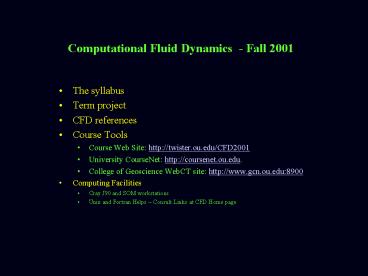Computational Fluid Dynamics - Fall 2001 PowerPoint PPT Presentation
Title: Computational Fluid Dynamics - Fall 2001
1
Computational Fluid Dynamics - Fall 2001
- The syllabus
- Term project
- CFD references
- Course Tools
- Course Web Site http//twister.ou.edu/CFD2001
- University CourseNet http//coursenet.ou.edu.
- College of Geoscience WebCT site
http//www.gcn.ou.edu8900 - Computing Facilities
- Cray J90 and SOM workstations
- Unix and Fortran Helps Consult Links at CFD
Home page
2
Introduction Principle of Fluid Motion
- Mass Conservation
- Newtons Second of Law
- Energy Conservation
- Equation of State for Idealized Gas
- These laws are expressed in terms of
mathematical equations, usually as partial
differential equations. - Most important equations the Navier-Stokes
equations
3
Approaches for Understanding Fluid Motion
- Traditional Approaches
- Theoretical
- Experimental
- Newer Approach
- Computational - CFD emerged as the primary tool
for engineering design, environmental modeling,
weather prediction, among others, thanks to the
advent of digital computers
4
Theoretical FD
- Science for finding solutions of governing
equations in different categories and studying
the associated approximations / assumptions
h d/2,
5
Experimental FD
- Understanding fluid behavior using laboratory
models and experiments. Important for validating
theoretical solutions. - E.g., Water tanks, wind tunnels
6
Computational FD
- A Science of Finding numerical solutions of
governing equations, using high-speed digital
computers
7
Why Computational FD
- Analytical solutions exist only for a handful of
typically simple problems - Can control numerical experiments and perform
sensitivity studies, for both simple and
complicated problems - Can study something that is not directly
observable (black holes). - Computer solutions provide a more complete sets
of data in time and space - We can perform realistic experiments on phenomena
that are not possible to reproduce in reality,
e.g., the weather - Much cheaper than laboratory experiments (crash
test of vehicles) - May be much environment friendly (testing of
nuclear arsenals) - Much more flexible each change of
configurations, parameters - We can now use computers to DISCOVER new things
(drugs, sub-atomic particles, storm dynamics)
much quicker
8
An Example Case for CFD Density Current
Simulation
9
Thunderstorm Outflow in the Form of Density
Currents
10
Positive Internal Shear
g1
Negative Internal Shear
g-1
11
Positive Internal Shear
T12
g1
Negative Internal Shear
g-1
No Significant Circulation Induced by Cold Pool
12
Simulation of an Convective Squall Line in
Atmosphere
Infrared Imagery Showing Squall Line at 12 UTC
January 23, 1999.
ARPS 48 h Forecast at 6 km Resolution Shown are
the Composite Reflectivity and Mean Sea-level
Pressure.
13
Difficulties with CFD
- Typical equations of CFD are partial differential
equations (PDE) the requires high spatial and
temporary resolutions to represent the originally
continuous systems such as the atmosphere - Most physically important problems are highly
nonlinear - true solution to the problem is often
unknown therefore the correctness of the solution
hard to ascertain need careful validation! - It is often impossible to represent all relevant
scales in a given problem - there is strong
coupling in atmospheric flows and most CFD
problems. ENERGY TRANSFERS. - Most of the numerical techniques we use are
inherently unstable - creating additional
problems - The initial condition of a given problem often
contains significant uncertainty such as that
of the atmosphere - We often have to impose nonphysical boundary
conditions. - We often have to parameterize processes which are
not well understood (e.g., rain formation,
chemical reactions, turbulence). - Often a numerical experiment raises more
questions than providing answers!!
14
POSITIVE OUTLOOK
- New numerical schemes / algorithms
- Bigger and faster computers
- Faster network
- Better desktop computers
- Better programming tools and environment
- Better understanding of dynamics /
predictabilities - etc.

